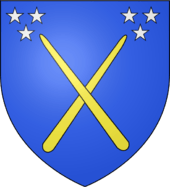Beauxbatons
Beauxbâtons (from French - "beautiful wands"[1]) is a French magic school in the fictional universe of Harry Potter created by the English writer J. K. Rowling.

Description
In the fourth book of the series, Harry Potter and the Goblet of Fire, students from Beauxbâtons arrive at Hogwarts to take part in the Triwizard Tournament. They arrive in a carriage, brought by winged Palomino horses.[1]
Beauxbâtons is described as a boarding school located in the Pyrenees mountains of southern France full of ice sculptures and forest nymphs.[2]
The delegation is led by headmistress Madame Olympe Maxime, a half-giantess; despite her proportions, she is beautiful, graceful, and well-dressed.[1] Also singled out is Fleur Delacour, the Beauxbâtons champion in the Triwizard Tournament, a beautiful girl with silvery hair who is a quarter-veela.
Students
Students of Beauxbâtons are described rather stereotypically, mainly as beautiful long-haired girls and attractive boys, in contrast with the serious and surly students from the Eastern European school Durmstrang.[1] They have good manners and in general are positive, while the unpleasant appearance of Durmstrang students implies their dishonesty. Similarly, the carriage of the Beauxbâtons is well-lit and nice, while the ship, by which the students of Durmstrang arrive, is gloomy.
They speak French and stereotypical, heavily accented English.[2][4] Jean-François Ménard, the translator of Harry Potter into French, wrote Madame Maxime as arrogant with very correct, aristocratic speech, while Fleur's tone was more distrustful. Ménard made these choices because "you cannot write French with a French accent".[5]
In the screen adaptation Harry Potter and the Goblet of Fire, Beauxbâtons students are all female and Durmstrang students are all male, in contrast to the books which portray both schools as co-educational.
Criticism
The portrayal of the two foreign schools has been criticized as stereotypical.[1] On the whole, the students of Beauxbâtons, just as the students of Durmstrang, are homogeneous, not showing the cultural diversity of Hogwarts.[6]
The contrast between Durmstrang and Hogwarts can be interpreted as an allusion to the war of the West with the bad from the East, as described in the gothic fiction of the fourteenth century, and contrast between Beauxbâtons and Hogwarts as an allusion to the competition between the reasonable and decent Great Britain and the licentious and decadent France.[4] It has been argued that the appearance on the foreground of these old conflicts allows J K. Rowling to sublimate them, and to make them irrelevant to modern readers.[4]
References
- Flotmann 2014, p. 329.
- Oziewicz 2010, p. 13.
- Flotmann 2014, p. 330.
- Moore 2000, p. 177.
- Oziewicz 2010, p. 11.
Literature
- Eccleshare, Julia (2002). Guide to the Harry Potter Novels. A&C Black. pp. 81–82. ISBN 9780826453174.CS1 maint: ref=harv (link)
- Flotmann, Christina (2014). Ambiguity in "Star Wars" and "Harry Potter": A (Post)Structuralist Reading of Two Popular Myths. Verlag. pp. 328–331. ISBN 9783839421482.CS1 maint: ref=harv (link)
- Henderson, Austin; Kenny, Madison; Lane, Cameron; Duc Le, Madison Murray (2017). "The Power of the Potter Patriarchy: Feminist Theory and Harry Potter" (PDF) (The mirror of Erised: Seeing a better world through Harry Potter and critical theory ed.). Cite journal requires
|journal=(help) - Moore, Miranda (2000). "Translatability of "Harry Potter"". 39 (6) (The Linguist: Journal of the Institute of Linguists ed.): 176–177. Cite journal requires
|journal=(help)CS1 maint: ref=harv (link) - Oziewicz, Marek (2010). "Representations of Eastern Europe in Philip Pullman's His Dark Materials, Jonathan Stroud's The Bartimaeus Trilogy, and JK Rowling's Harry Potter Series". International Research in Children's Literature (International Research in Children's Literature ed.). 3 (1): 1–14. doi:10.3366/ircl.2010.0002.CS1 maint: ref=harv (link)
- Rana, Marion (2009). Creating Magical Worlds: Otherness and Othering in Harry Potter. Peter Lang. ISBN 9783631580714.CS1 maint: ref=harv (link)